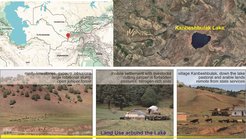Tracing Anthropogenic Changes and Environmental Evolution in Central Asia (TRACE)

Understanding historical land use changes and their environmental impacts is critical for reconstructing the long-term relationship between human societies and ecosystems. This project focuses on Lake Kanbeshbulak, Uzbekistan, to test the applicability of multiple geochemical and biological proxies—plant wax biomarkers, compound-specific isotope analysis (CSIA), polycyclic aromatic hydrocarbons (PAHs), and fecal biomarkers—in reconstructing land use history, urbanization patterns, and the onset of the Anthropocene in Central Asia.
Lake Kanbeshbulak is an ideal study site due to the availability of a high-resolution age-depth model and pollen data, which have already provided valuable insights into past forest dynamics and ecological restoration processes. These findings align with archaeological and historical records, making this site a prime location to explore how novel biomolecular proxies can complement traditional paleoenvironmental studies. By integrating biomolecular, paleoecological, and historical approaches, this project aims to validate the use of plant wax biomarkers, CSIA, PAHs, and fecal biomarkers as reliable proxies for land use and urbanization history in Central Asia. This research will contribute to a deeper understanding of:
The environmental impacts of human land use over millennia.
The transition to the Anthropocene in Central Asia.
How past ecological restoration processes can inform sustainable land management today.
Ultimately, this study seeks to enhance interdisciplinary methodologies for reconstructing historical landscapes, providing valuable tools for both archaeology and environmental science.











